The New King of the Court?
How pickleball became the hottest sport in the United States, and what sport might experience exponential growth next
This past spring, the unthinkable happened: a local country club began converting tennis courts into full-time pickleball setups. The backlash was immediate, but didn’t change the fact that 2 of the 4 courts were never restored for tennis during the summer, and it’s now likely that the change will remain permanent and the club may need to add new tennis courts to the property in order to satisfy all parties. Aside from the obvious questions this episode raises about the inner machinations of the decision making entities in suburban country clubs, my biggest thought observing from the outside was: “I didn’t expect pickleball would have this type of growth and staying power. How did I not see this coming?”
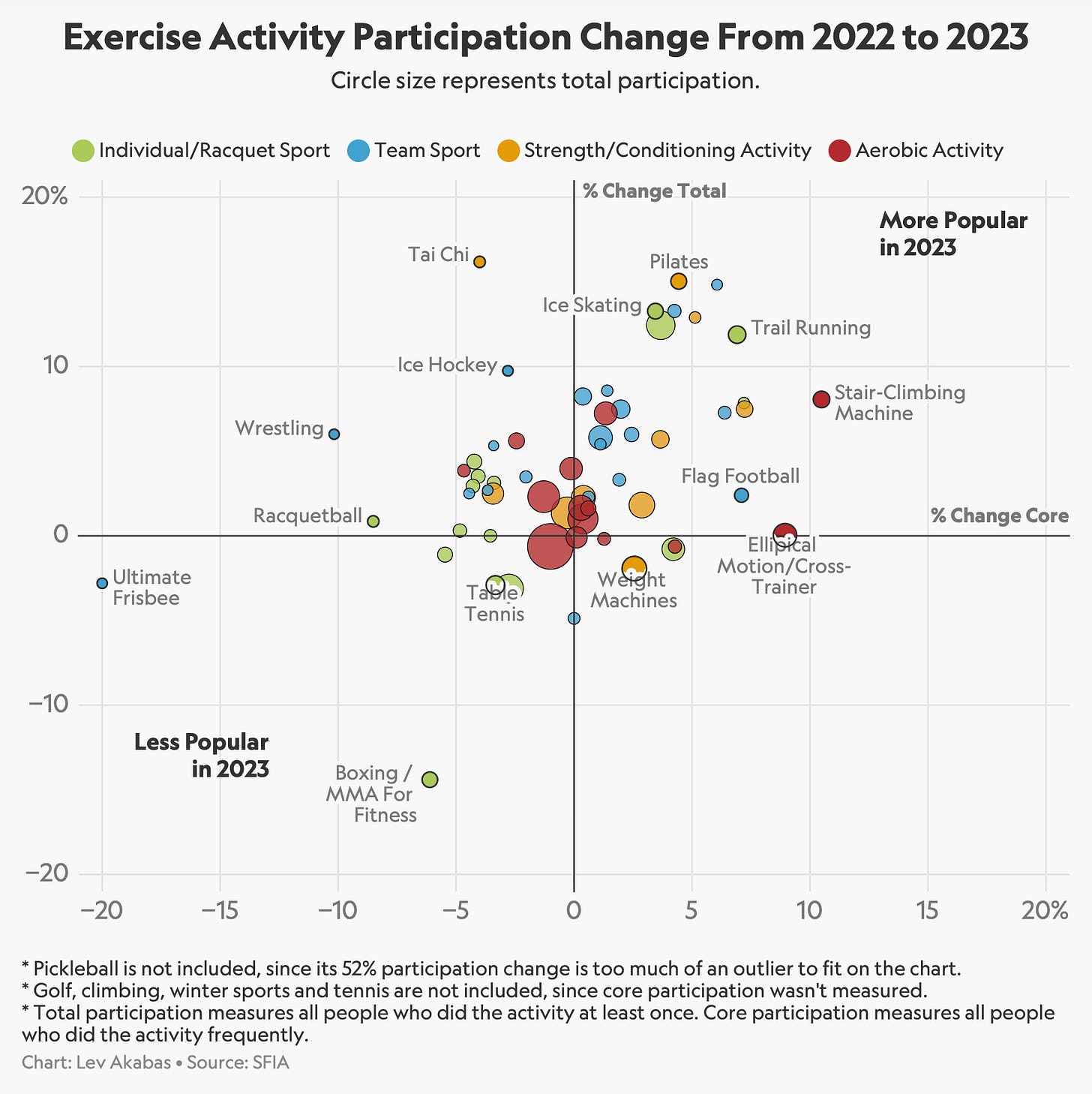
This question has swirled in the back of my mind for a couple months since the club closed on labor day, signaling a temporary detente for the winter. Like all things that swirl in my mind, I wanted to organize my thoughts in the form of an article, and perhaps even more importantly, I had to find someone to analyze this topic with me since it turns out to be quite complex. Luckily, I had just the target for item number two: my childhood friend and now first-time Geek Locker co-author Leo Fondriest! Of course, when you add firepower to a team, your scope starts to creep, so our single question morphed into three distinct investigations.
First, we wanted to figure out why pickleball itself exploded in popularity, and seems to be at least maintaining some of its momentum— an echo of the original prompt. Second, we wanted to look backwards to see if we could map pickleball’s features and any external factors to previous sports and games that took off and sustained some level of popularity. Third and finally, we wanted to take a crack at guessing what existing sport or game might explode in popularity next, based on the same set of factors. Spoiler alert: predicting the future is hard, but we landed on an interesting framework for assessing the growth potential of sports and games that might be useful in the future.
Coincidentally, most people (including ourselves) wouldn’t have even previously selected pickleball as the next big, new game in town— in part because it’s not actually new. Pickleball was actually created in 1965 by US congressman Joel Pritchard, who was just looking for a way to pass time with a new yard game that could be played by his whole family. USA pickleball believes that the sport was being played in all 50 states by 1990, and by 2003 there were just 39 known permanent places to play pickleball in all of North America— not necessarily the standard growth precursor for an exponential rise in popularity. However, by 2008, there were over 420 registered pickleball locations in North America, a 10x increase in the span of just five years that might have been an early signal of the explosion to come. Another 10 years passed, and by 2018 there were over 7,000 known pickleball sites— another 10x increase that capped a more sustainable pre-pandemic growth trajectory than we expected to find, while putting in place the infrastructure for the exponential growth that happened next.
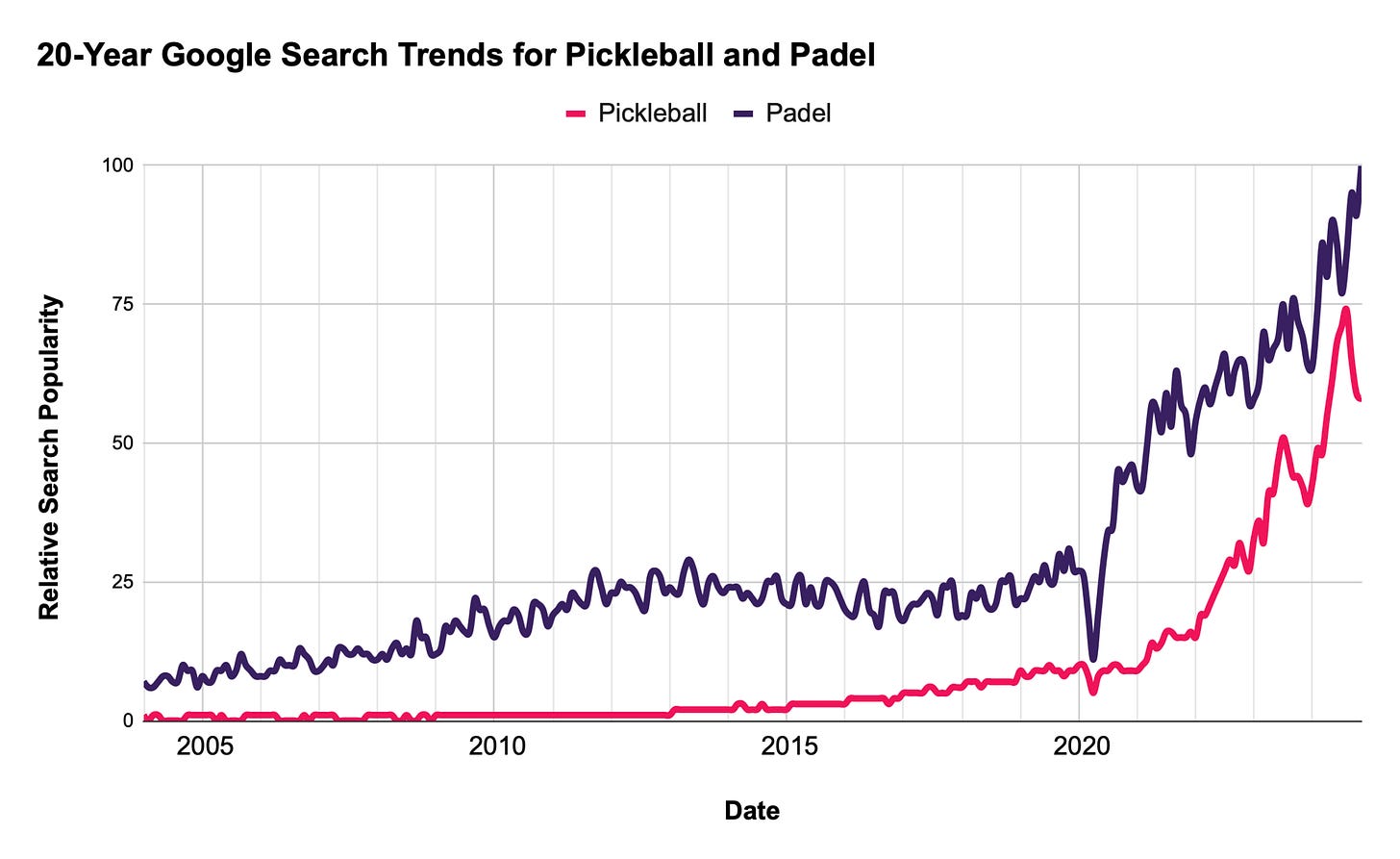
After a relatively reserved period of growth during the peak of COVID restrictions in 2020 and 2021, the dam finally broke. Through 2022 and 2023, the sport exploded in popularity and national interest, becoming the highest growth sport in the US, particularly in more affluent areas of the country (which often correlates with older generations). The sport nearly doubled its participation in 2023, with an annual growth rate of 85.7%. By 2024, almost 50 million people in the US had tried pickleball within the past 12 months, though the number of consistent players is likely much lower by most accounts. From 2021-2023, most market researchers suggested that the overall size of the pickleball equipment and apparel market has nearly tripled, despite inconsistent assessments of the total market value. Looking forward too, most business analysts still predict sustained growth in the realm of 9-15% CAGR over the next decade, reflecting high optimism relative to other gear markets like hockey despite modest international growth to-date.
Currently, the US and Canada dominate pickleball participation, with North America composing roughly 50% of the global revenue generated by the sport. Although this means the growth potential across the rest of the world is quite high, the near simultaneous rise of Padel as a competing racket sport poses challenges, particularly in South America and Europe. Both sports cater to very broad audiences, with pickleball’s adoption being widespread across all age ranges, including ~30% of players being older than 55, and another ~30% being aged 18-34. For an athletic game, this is a pretty remarkable feat, which brings us full circle back to the first question: why did pickleball explode in popularity across such a large market demographic?
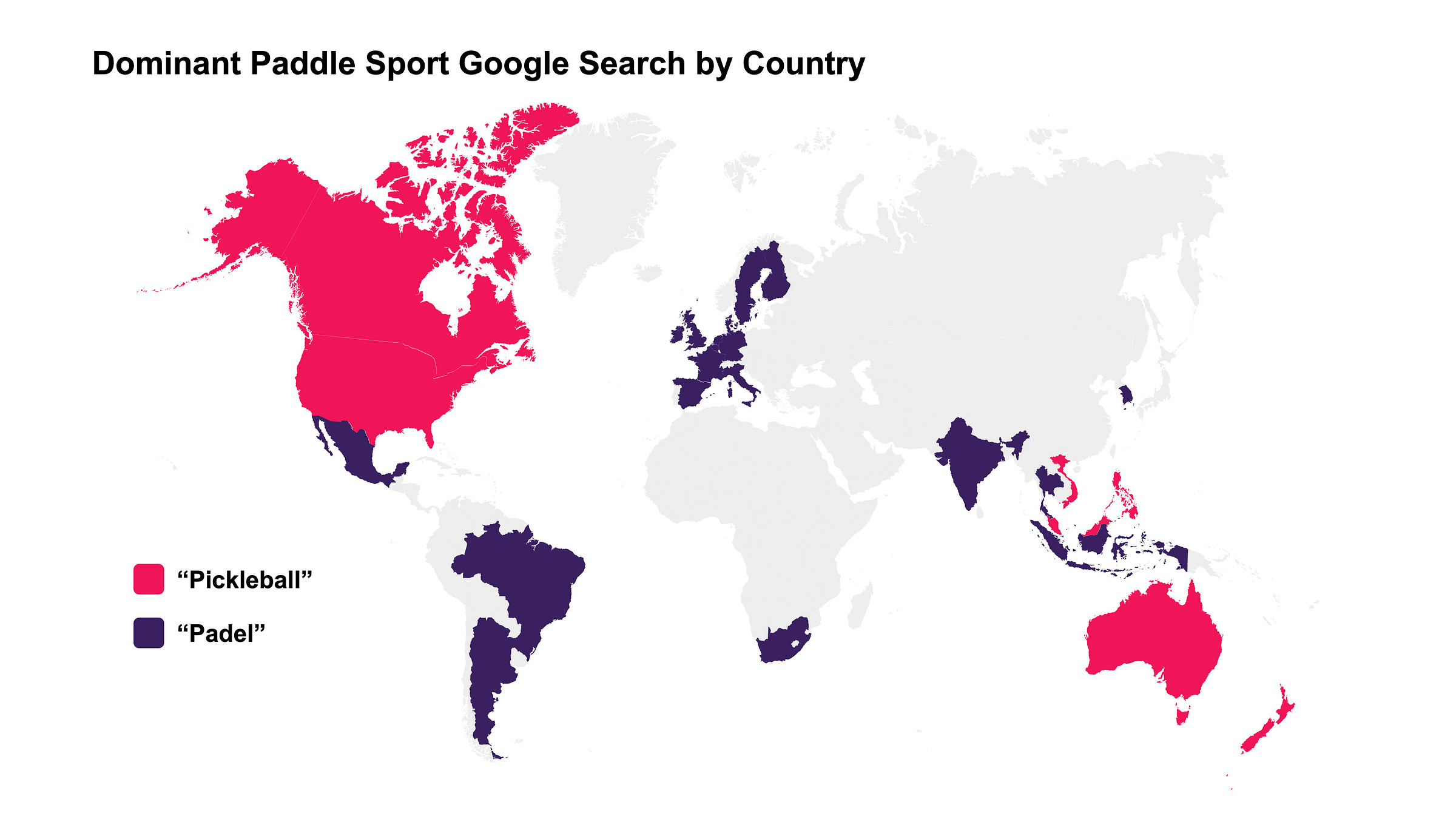
Most novelty sports face an uphill battle to break into the already saturated sports and recreation market. People already have their exercise routines (and associated financial investments) established, so new entrants often take years to build a following, only capture a niche market, and/or lose traction after a short period of relevance. Spikeball, Ultimate Frisbee, and even Pokemon GO all stand out as examples that either never quite reached a massive peak or stayed relevant for as long as initially expected, even if we all believed for a few weeks that Pokemon GO might be able to usher in world peace. Pickleball on the other hand, seems to have overcome all of these challenges. It exploded in a seemingly viral moment, captured a wide range of demographics, and (so far at least) appears to have lasting power.
The speed of pickleball’s ascent can, in part, be attributed to the ways in which it leverages existing user knowledge and infrastructure. Though the nuances of pickleball are novel to many people, the sport is at least familiar the first time you see it, with prior reference points in tennis, ping pong, or other racket/net sports. The rules are similar to something you likely already know, and the mechanics are intuitive if you’ve swung a racket before. Importantly, pickleball can also be played on a variety of existing surfaces, both indoors and outdoors. Tennis or basketball facilities can easily be converted to accommodate the sport, which makes it cheap to set up and available in any region of the country year-round. This combination of quick learning and easy access primed pickleball for explosive growth, especially when paired with low barriers to entry, and a unique post-pandemic desire for active outdoor socialization.
Part of pickleball’s appeal also comes down to how quickly and how easily anyone can go from knowing nothing about pickleball to being an avid “pickler.” Even if you haven’t heard of pickleball before reading this article, I almost guarantee you could fall in love with the sport by the end of the week. A well-reviewed pickleball set with 4 paddles and 4 balls costs you $23.99 on Amazon and can be delivered tomorrow. That leaves you one whole Sunday to walk on over to your nearest tennis courts or maybe even indoor basketball courts, where you’ll likely find pickleball lines painted or taped on top of the existing court. Depending on your age and athletic ability, you can either play an intense game where you are sprinting around the court and smashing the ball at every opportunity, or you can play at a much more casual pace focusing mainly on dinks and doinks.
Crucially in all of this, pickleball is quite easy to learn. We have no hard data to support this, but when thinking about the learning curves of different sports in terms of how long it takes to learn vs. when it gets fun (see the beautiful illustrative graph below), most major American sports tend to peak after long time investments. Learning how to properly hit a baseball, shoot a basketball, throw a football, or (god forbid, according to Leo) skate can take months if not years of practice. Pickleball on the other hand benefits from its similarity with other sports, and can often be learned to an enjoyable level within a day, and it continues to get more fun the better you get. It’s the perfect balance of an activity that is simple, moderately athletic, and social.
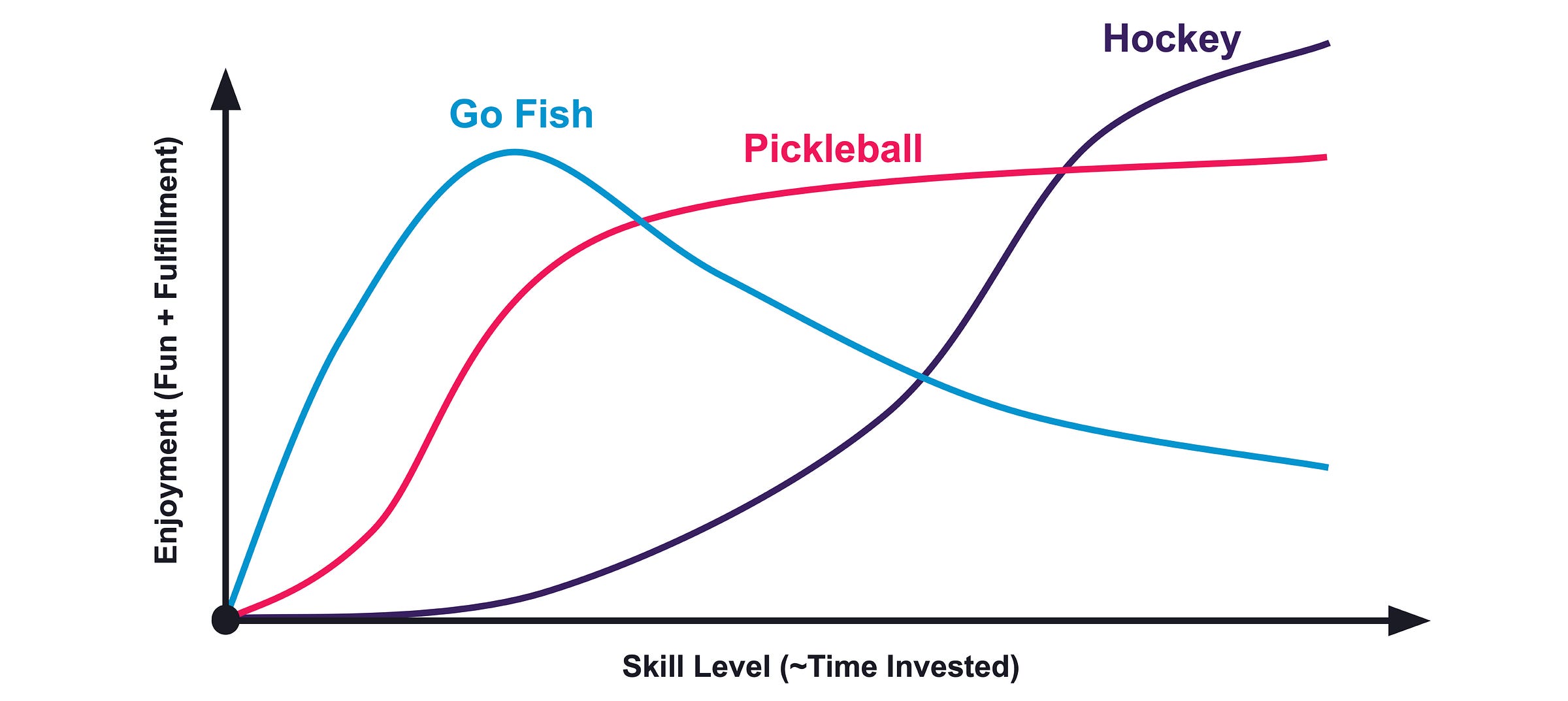
On the social front, pickleball seemed to capture a unique moment coinciding with a broader shift away from team sports, which not only accelerated pickleball’s growth, but also helped pave its path to sustained relevance. Coming out of the pandemic, people were seeking low-commitment, socially distant, physical activities. Pickleball is just the right combination of socializing and exercising to fill this niche, and it’s a quick game so it’s easy to rotate through groups of six or eight players. Given this social element, it also became somewhat of a cultural movement with a significant social media presence. Perhaps because it seemingly came out of nowhere, it became a trendy sport for everyone. Unlike other sports with superstar athletes, major leagues, and elite-level highlights, pickleball had few public comparison points— a void that made it more casual and social for people who might typically shy away from publicizing their athletic pursuits.
Athleisure brands, startup pickleball equipment companies, and online personalities also jumped on the trend and flooded social media with everything from brand recommendations, to basic how-tos, to trick-shot videos. Meanwhile, the rise of pickleball coincided with the aforementioned downward trend in team sports participation in the US that has been ongoing since 2015. Of the 10 fastest growing US sports in 2023, only three were team sports, and two of those three (Swimming and XC Skiing) can also be individual. In other words, part of pickleball’s growth story is rooted in being in the right place at the right time, and if current cultural trends continue, pickleball looks destined to remain relevant for a long time to come.
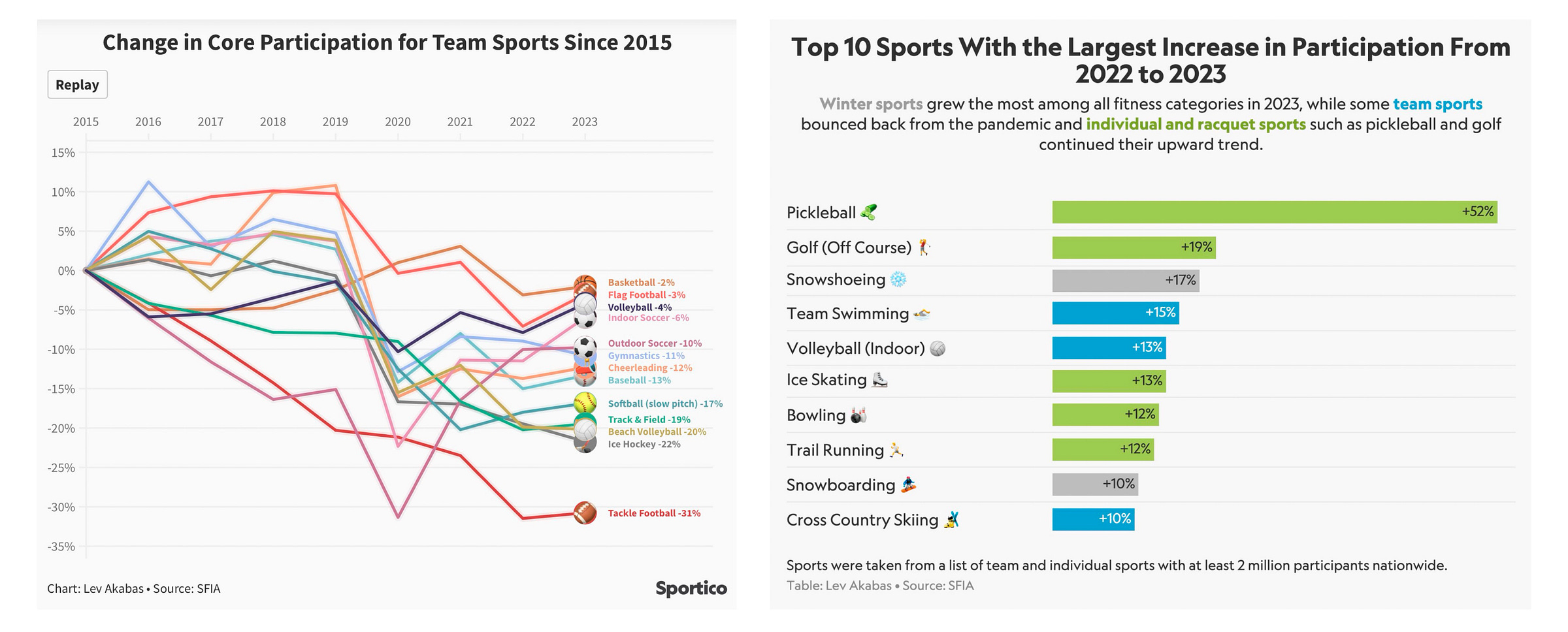
Despite being the current focus of the athletic zeitgeist, pickleball certainly isn’t the first sport or game to captivate a large audience by offering a social, accessible, and culturally relevant activity. There are many historical examples of novelty sports that either experienced fleeting viral moments or actually broke through and established sustained popularity. The table below categorizes a handful of examples, but there are dozens more that could be cherry-picked for comparison and analysis. If anything this exercise really highlighted just how many new sports have been invented, despite how stable the popularity of major sports leagues feels.

Among this list, three stood out as particularly relevant: Wii Sports, Spikeball, and Snowboarding (a classic trio).
Though not an immediately obvious comparison point, we landed on Wii Sports as the closest parallel to pickleball’s meteoric rise. Wii Sports provided mild exercise in a social format, it leveraged existing technology and knowledge in the form of TVs and a controller that functioned like a remote, and it captured a new social wave around motion-controlled gaming. Interestingly, it was also highly accessible across age groups (see NPR’s article on the National Senior League's Wii bowling competition). Wii Sports became a household or at least a neighborhood staple, and it managed to convert non-gamers and non-athletes into avid virtual tennis players, bowlers, and boxers. Similar to pickleball, Wii Sports captured the balance of offering a new activity that was physically engaging, moderately competitive, and exciting without needing prior skills or knowledge. It eventually faded in terms of cultural relevance due to technological advancements, but it still holds the title of the 4th highest selling video game of all time.
Similar to pickleball, Spikeball had a rapid growth moment in mid-2015, actually thanks to a Shark Tank pitch! Though the deal made on the show ultimately fell through, the new sport took off with a younger, mostly college-age crowd and thrived in casual environments. It shared many of the strengths of pickleball: affordability, casual/social exercise, and fun/marketable content. It even had the advantage of being completely mobile— all you needed was sand or a patch of grass to play. However, spikeball also had a few major drawbacks that prevented it from ever reaching that next level of sporting success. Unfortunately, Spikeball is not particularly age-accessible or familiar (even for volleyball players), and it’s difficult to become decent enough to enjoy it within one or two sessions. Spikeball certainly had promise as a breakthrough sport, but ultimately has only been able to capture and retain a somewhat niche market of customers.
Finally, given the extremely long history of skiing, it’s pretty shocking that modern snowboarding wasn’t really popularized widely until the late 1970’s, sparked by the eponymous Jake Burton Carpenter. Snowboarding really attracted a younger, more rebellious demographic than a sport like pickleball, in part due to the difficult learning curve in transitioning from skiing. It was just different enough from a physical and mental perspective that it didn’t attract as many existing older skiers, but it leveraged all the same infrastructure as skiing, and snowboarders didn’t lose any of the social aspects of resort skiing either (unless they were slow to buckle at the top of the lift). Despite taking off before social media, snowboarding eventually leveraged the same mechanisms as skateboarding to become an action sport darling, later becoming an Olympic sport, perhaps the most coveted title a new sport can achieve (shoutout to flag football).
Of course, hindsight is always 20-20, and the real challenge is predicting what’s to come. So, taking all of this into consideration, we thought it would be fun to take a guess at what could be the “next pickleball.” Enumerating the individual factors highlighted above that we think really enabled pickleball to explode helped us narrow the search and “grade” potential candidates. Though this set of criteria might not be completely mutually exclusive, it does provide a semi-formal framework for evaluating and comparing sports that could prove quite useful to guide investment or game design in the future. If for some reason this article takes off, we’ve unofficially coined this analysis the Fondriest-and-Douglas Index (the “FAD Index”)— subject to future copyright and modification, of course.
Marketable: Fun to share on social media, generates compelling content
Flexible (Time): Can be played for any amount of time from 5 minutes to 5 hours, rather than requiring a set amount of time like a soccer game
Logistically Accessible: The majority of the country can feasibly play the sport year-round without new facilities needing to be built
Organizationally Simple: Can be done individually or in small groups. No need to rely upon a team or an organizing committee for a league
Age Accessible: Can be fun for any athlete from age 10 to 100. Even better if it can be played cross-generationally
Familiar: Leverages the rules and/or mechanics of a more popular sport
Social: Creates natural socializing opportunities either via time in between games or due to the casual play style
Physical: Active enough to be considered exercise without being extreme or dangerous
Fast Fun: Novices can reach a skill level at which they will enjoy the sport within a matter of days
Low-cost: Low price point for equipment and/or rentals
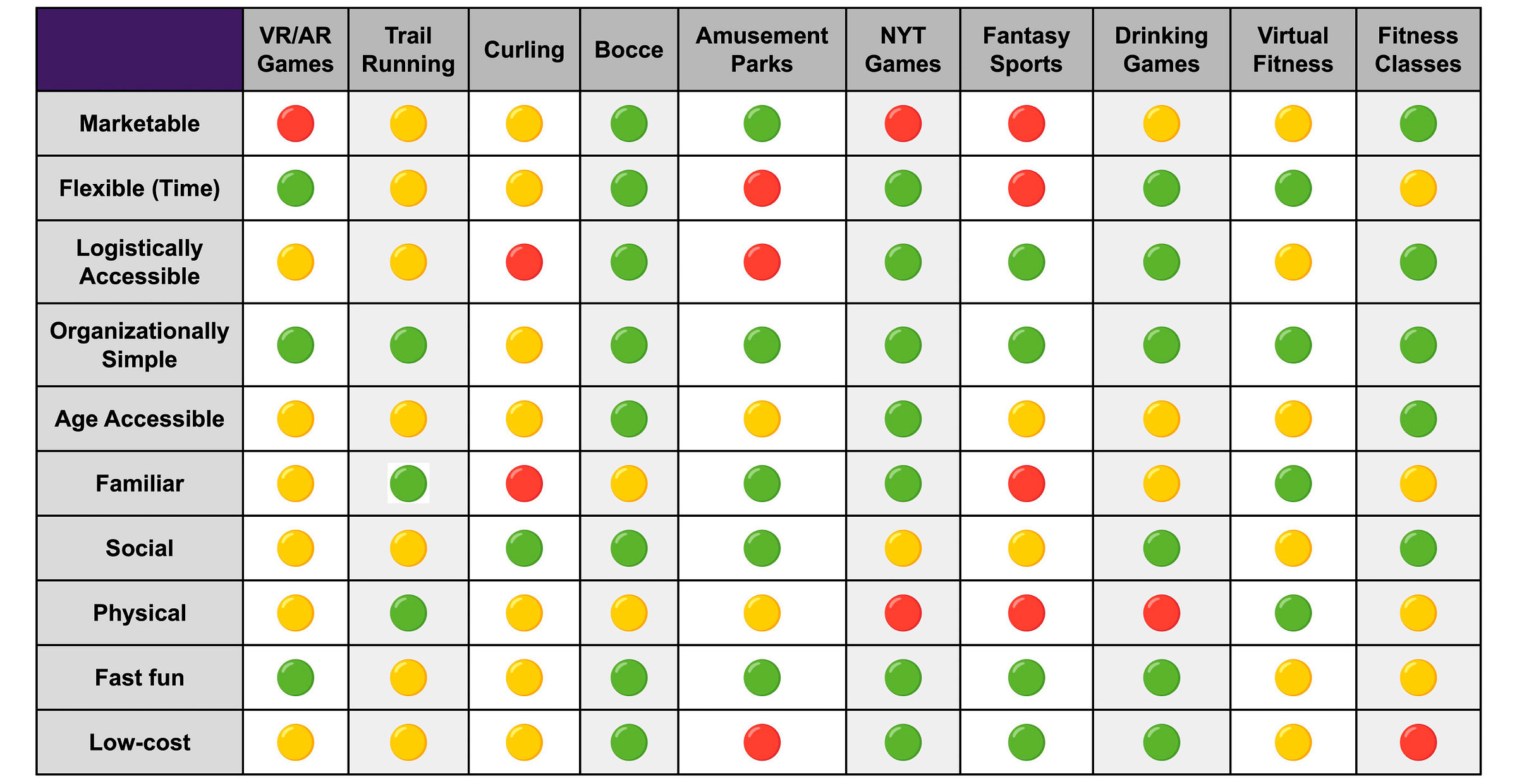
Maybe surprisingly, based on these criteria, bocce seems like the most likely sport to seize the next viral growth moment! Others like Virtual Fitness and Trail Running are not far off the mark either, despite the three of these sports being radically different from one another. Other than not being quite as athletic, it has almost all of the same characteristics as pickleball: it’s simple, familiar, social, physical, mobile, fast, cheap, and age accessible. While we don’t see it necessarily replicating pickleball’s meteoric rise, we wouldn’t be surprised if we started seeing bocce being played in more public parks, and eventually maybe even starting to carve out a little space in those country clubs. It might even be a great foundation for someone looking to create a brand new sport if they can fold in some more athletic elements.
Again, bocce might sound like a surprising example of a high growth-potential sport, but we would have said the same thing about pickleball! Pickleball emerged in a crowded paddle-sport market after over 50 years of demonstrating modest growth, but checked every box for customers looking to socialize and play a fun game. At the very least, hopefully this analysis sparked some of your own thoughts about the rise of pickleball and what might come next!
In any case, it would be quite exciting to watch the battle over converting practice greens to bocce arenas at country clubs…





